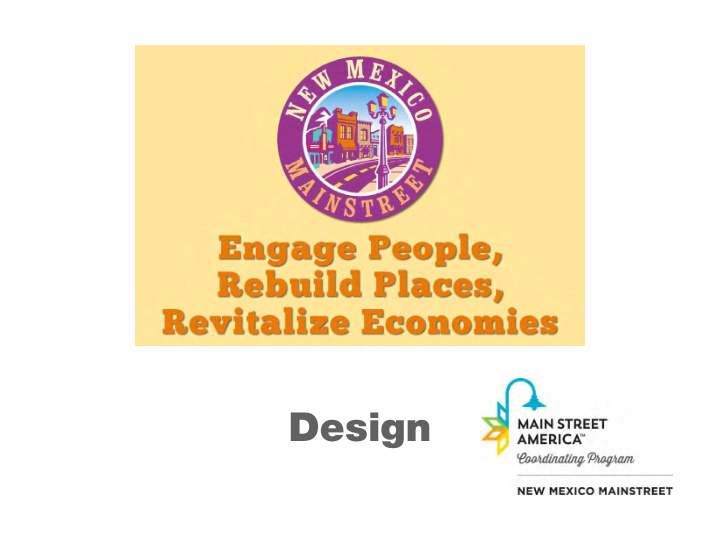



Design
History behind “Main Street” • Historically, Main Street was the community’s primary commercial hub (pre ‐ WWII). • Suburbanization and marketplace changes created a movement away from traditional commerce centers. • Changes in local and federal policy affected how historic buildings were managed, maintained. • “The Main Street Approach” is a movement to preserve historical assets while rebuilding vital economies in it districts.
Design Point Design means getting Main Street into top physical shape. Capitalizing on its best assets — such as historic buildings and pedestrian-oriented streets — is just part of the story. An inviting atmosphere, created through attractive window displays, parking areas, building improvements, street furniture, signs, sidewalks, street lights, and landscaping, conveys a positive visual message about the commercial district and what it has to offer. - National Trust’s National Main Street Center
Design Point • Educating others about good design – enhancing businesses as well as the district • Providing good design advice – encouraging quality improvements to private properties, public spaces • Planning your district’s development – guiding future growth and shaping regulations • Motivating others to make changes – creating incentives and targeting key projects • Supporting and/or driving physical improvement projects
Design Education experience exploration input
Community Engagement
Transformation PROCESS: Partnership building Incremental/catalytic change Community buy-in Enthusiasm building PHYSICAL CHANGE: Trees + landscaping parkways Wider sidewalks Lighting Crosswalks Paving materials Curb extensions + bump outs
OUTCOMES: Traffic calming Higher spending Higher visibility Reduced crime More walkability (park once) Multi-modal connections Social interaction Cultural/historic expression Higher property values Promotion of local assets Space for events Safety and accessibility
Transformation
Paint Paint is an amazingly magical substance for transformation. Expressing architectural character while also providing a barrier from the elements - paint can be one of the best tools in the revitalization toolbox. When painting a building try not to exceed a palette of three colors and trim typically will be the darkest of the colors.
Awnings The addition of awnings can be a simple way to add character to buildings with unremarkable facades and they also have utilitarian functions. Awnings can help to lower air conditioning costs, provide shelter to pedestrians and reduce merchandise from UV fading.
Signage Business signage often is one design tool under utilized. A good sign is worth its weight in gold. Drawing potential customers in and enhancing the downtown - signs are often not given the proper attention they deserve. The most successful signs are compatible with the character of the building and the image of the business.
Window Displays Use windows to inject vitality. Visual displays not only sell the merchandise selected; they set the image of the business. Fresh, creative displays that target only a few ideas of items come to life with dynamic arrangements, selective color, and good lighting. - National Trust’s National Main Street Center
Historic Preservation/Ethic Common projects for historic buildings within your downtowns involve returning them to their original beauty. Some of these projects might include uncovering transom windows, removing “slip covers” and stabilization of historic materials. Historic preservation for sites and streetscapes is also important and may include consideration of street pattern, features, materials and/or views that are considered contributing or significant.
MainStreet Façade Squad
Placemaking / Urban Design
Placemaking In creative placemaking, partners from public, private, non-profit, and community sectors strategically shape the physical and social character of a neighborhood, town, city, or region around arts and cultural activities. Creative placemaking animates public and private spaces, rejuvenates structures and streetscapes,improves local business viability and public safety, and brings diverse people together to celebrate, inspire, and be inspired. National Endowment for the Arts
3-part focus 1. Place-based 2. Community-centered process 3. Integration with other strategies - Center for Community Progress
Temporary/Pop Up Installations Christina Sporrong “TaranTula”
Mobile Connections to Place Lauralin Kruse and the Mobile Museum of American Artifacts
Community Designed/Built
Professionally Designed/Built
Combining Scales for Maximum Impact
Great Blocks on MainStreet Public infrastructure investment • Innovative and intensive design redevelopment project within the MainStreet/Arts & Cultural district • Focusing on a viable core two- to-three block commercial area • Resulting in “shovel-ready” construction documents • Public infrastructure investment to catalyze and leverage private sector reinvestment, resulting in higher economic performance
Adaptability • What constitutes creative placemaking is unique to each community, which makes it uniquely suited to local economic development • Creative placemaking projects are designed to be flexible and adaptive, evolving with the community and supporting long term vitality
Great Blocks on MainStreet
Wayfinding
Wayfinding
Downtown Master Plan/MRA Plan
Economic Impact • Partnerships that result in investment • Activation of space / “Eyes on the Street” • Recirculates residents income at a higher rate • Youth retention/training next generation of cultural workers • Re-uses vacant/underutilized land, buildings and infrastructure
Economic Impact • Creative Placemaking fosters entrepreneurs and cultural industries that generate jobs and income, spin off new products and services, and attract and retain unrelated businesses and skilled workers. National Endowment for the Arts
For more information or questions… NMMS Design Revitalization Specialists Amy Bell 925.788.3423 William Powell 505.603.3747
Recommend
More recommend